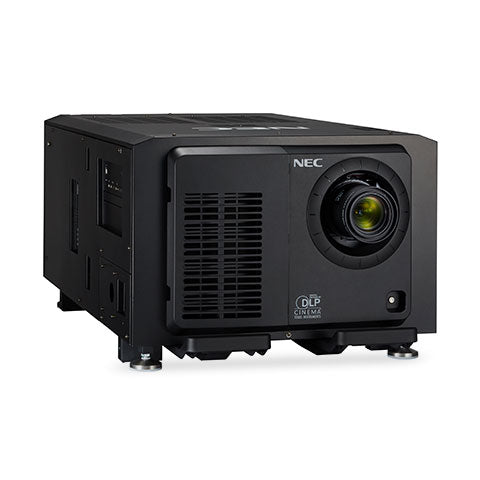Visualizing projectors might well create a perception of the "3... 2... 1" film reel countdown on movie theater displays of yore or cumbersome classroom equipment trundled on a chalk dust-covered cart. Still, modern projectors couldn't be more dissimilar to these relics.
New brightness levels, image quality, and connectivity options made possible by technological advancements make projectors ideal for unusual or challenging applications, such as areas with high ambient light, uneven surfaces, or acute angles, across various verticals.
Functional and Flexible
Projectors provide flexibility to designers and installers that digital screens don't always have.
Projection in store windows, for instance, is made possible by projectors with film or glass technology to see the display from inside and outside the building. Other forms of visual technology cannot accomplish this.
Projection mapping is a captivating method of showcasing content in dynamic settings. It involves using projectors for flashing images onto various surfaces (such as stone, ice, metal, and more). For example, the Cleveland Cavaliers home court, Quicken Loans Arena, features 3-D images projected onto the court that they use to make a spectacular entrance.
For a truly immersive experience, some applications map content around digital displays, as seen at the Amsterdam RAI Convention Center, where content is projection-mapped around a video wall, giving convention goers a double dose of digital display technology.
Projectors additionally produce redundancy. By overlapping multiple projectors on a single screen, projection stacking increases the projected image's brightness and serves as a backup in case a projector shuts down unexpectedly.
In addition to appealing to those on a tighter budget, projectors offer more screen real estate for the dollar because their cost per square inch is lower than that of displays. They're great for places that need to show large-format content but can't support the weight of a heavy digital display.
Tips for Proper Projector Setup
Some things to keep in mind before installing a projector for a digital signage project include:
Both natural and artificial lighting: It's essential to think about the different seasons and times of day when designing a room with windows that face outside. Today's projectors may be brighter than in the past, but a darker room still provides the best viewing experience and image contrast.
In terms of how far away you are, you can: Plan the distance between the projector and screen based on the screen size. Generally, manufacturers list the range of image sizes at various "throw" distances from the screen.
The image size from a given throw distance will be affected by the lens's focal length, so it may make sense to use a projector with interchangeable zoom lenses (optional) for proper placement.
Aspect ratio: Screen size should be determined concerning the maximum distance from the screen; for example, if the maximum distance from the screen is 32 feet, an eight-foot screen would be appropriate. Depending on the size of the text and the graphics contained within the image, the aspect ratio may shift.
Brightness: While common knowledge dictates that brightness specifications in the 2,000 to 5,000-lumen range are suitable for many indoor applications, this is not always the case: More than 5,000 lumens of light output may be necessary for some situations.
For instance, a projector with a brightness range of 8,000 to 21,500 lumens and higher is preferable with more giant screens, brighter ambient light, and longer throw distances. The brightness of the projected image can also be improved by using a screen made of a material that can collect and direct the light from the projector. This ability is called "screen gain" and can be used to increase image brightness with a lower lumen. In other words, it's a projector that can see the future. Due to the screen's higher reflective properties, the offset angle will change depending on the intended audience's location (viewing angle).
Using data and video: Customers may want to show content from video/data sources, such as Blu-ray players, laptops, tablets, and other smart devices, on the projector. Composite video, s-video, component video, HDBaseT, DisplayPort, and HDMI with HDCP are popular signal source connections.
An established practice today is to transfer data from a source to a projector using a network. Some sources, such as HD video, are better sent via cable because wireless network bandwidth may not be fast enough to ensure good video quality. If an integrator plans to set up lines to run to the projector, consider the optimal location for the cable connectors to be available to users.
After planning for traditional analog/digital input connections from local multimedia devices, the next thing to consider is network connectivity for accessing network content and remote administration.
Not all projectors need to be connected to a network, but it can be helpful from an asset management standpoint. An administrator can remotely monitor and manage projectors and even turn them on and off, extending the lamp life.
Examining a Variety of Laser Projectors
Integrators can now offer their customers laser projectors as an alternative to the more commonplace lamp-based projectors.
Solid-state lighting comes in many forms today. Low-brightness LED (light-emitting diode) projectors are sufficient for use with lower-sized screens. You can choose from various laser phosphor projectors with features and specifications. If you're looking for the brightest of the bright, RGB laser is an option that gives you access to a broader color gamut up to Rec. 2020.
With a typical lifespan of over 20,000 hours, lasers are up to 10 times more long-lasting than the lamps used in traditional installation projectors. Compared to projection lamps, which may need to be replaced as often as once every year or two, the laser projector has an expected lifespan of more than six years.
Despite its higher initial cost, consumers will save money in the long run by investing in laser phosphor. We can save money on energy and maintenance by eliminating the need for lights. Particular laser projectors can save money in the long run because they don't require filter replacements as frequently as once every few months.
In addition to producing a picture that is both bright and clear, the multiple lasers in a solid-state projector help prevent power outages and lost data. If multiple laser diodes fail, the system's electronics will collaborate to maintain a consistent level of illumination and color.
The laser projector's long lifespan and low rate of brightness decay ensure that the projected image remains bright for a more extended period. Images retain their crispness, and their colors don't fade. Recent laser phosphor projectors have display resolutions as high as 4K.
Making Sure We Find the Best Answer
Finding the best method for a given task is crucial to completing any project.
Using projectors, integrators can transform any space into a dynamic environment, providing a memorable experience for guests while boosting their own business through satisfied clients.

